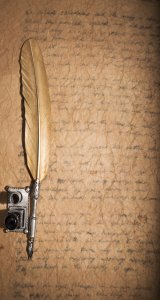Picture Framing for Photographers - Part 2
There are two sources for obtaining the moulding for making a frame. You can firstly start with a straight piece of timber, and using a home routing system make your own moulding shape with a rebate to take the art work. Alternatively you can pick from a large range of ready finished mouldings available from your local frame shop or hardware store. I recommend the latter. It's easier, the choice is much wider, and it's more cost effective. However, one word of warning. Always look for a moulding with a good straight back and not too flat on the surface. If the moulding has a bump or some raised section in the top surface it will cut and join easier than a flat moulding. Most mouldings are made from pine or obeche. These are soft grain timbers and cut and join well. Hard timbers like ramin are more difficult to work with.
Measuring and Cutting
How much moulding will you need? The outside dimensions of the frame are determined by the size of the mounted photograph. Carefully measure the overall size of the matted picture you're framing, adding a little extra (3-smm) for "play" to ensure the picture fits easily into the finished frame.
Add the length and the breadth together, then double the total. This will give you the overall length. But you also have to allow for the mitre cuts, so multiply the width of the moulding by 10 and add this to your total (total length required = 2 x (length + breadth) + 10 x width of moulding). The 45 mitre cuts are most important - a bad cut will never join properly and will always look terrible. There are a number of machines on the market for cutting 45 degree mitres starting with the simple mitre box, radial arm saw with a mitre attachment, or a commercial mitre saw (see picture 1).
Cutting one side of a frame is easy. Cutting the second side to be EXACTLY the same side to the first side is the hard part of frame cutting. Using a measuring system you can cut lengths accurately every time. The FrameCo measuring system will attach to any brand of electric or manual mitre saw and will make the cutting of the frames quick and foolproof.
If you have a saw you can cut without using a measuring system. Follow this easy step-by-step guide to cut mitred lengths for your frame:
* Calculate the dimensions of your frame.
* Place the moulding into the saw.
? Cut off a small piece at 45 degrees with the saw in the lefthand position.
* Remove the moulding from the saw.
? With a tape, measure along the back of the moulding, to the length you require.
To this length you have to take into account the size of the moulding you are using. So you add to the length of the side an amount equal to twice the moulding width - not including the rebate. Then make a pencil mark on the back of the moulding near the top so that you can see the mark.
? Put the moulding back in the saw and align the saw blade on the pencil mark.
? Swing the saw around and cut the next mitre.
? Place the two pieces back to back so you can transfer the size you have just cut to the back of the moulding length.
? Repeat the cutting procedure for the other pieces.
Joining the Frame
To ensure a tight and stable joint, glue should be applied, especially if the frame is large. A light smear of a good quality PVA glue is all that's necessary. Although it is possible to buy clamps that join two corners at a time, it's simpler and quicker to clamp all four corners at once. This allows you to see how the corners match up before gluing and securing the mitres. There are several types of clamps...
Cord Clamps: This simple, but effective clamping system works well for small to medium-size frames. It consists of four flexible plastic corners and a length of cord. (See picture 2).
Metal Strap Clamp: This clamping system is slightly more sophisticated and consists of a metal strap, flexible corner pieces and a screw operated tensioning device which allows you to apply a considerable amount of tension so that the corners are pulled together tightly. The Strap Clamp is suitable for large and small frames. (See picture 3).
Once the frame is clamped together and you've made sure all the corners are aligned, then the mitre joint should be secured or reinforced. Glue alone is not safe and secure enough for most sized frames. Here are some options.
Panel Pins: You can nail a panel pin across the mitre. It is advisable to pre-drill the holes and secure the joint in a vice before hammering the pins into the frame. Punch home the nail head and fill the hole with a coloured woodfiller.
V-Nails: Professional framers use these v-shaped staples, which are inserted using a special manual or pneumatic joining machine. The "PushMaster" is a DIY version of these machines and is suitable for low-volume high-quality framing such as required for photography or portrait framing.
Biscuit Joints: More suitable for large and heavy frames such as mirrors. Most commercial picture frame mouldings are small and a biscuit joint is not necessary.
V-Nail Joining Machines There are several models of these machines and all are suitable for the DIY or low-volume picture framing. Here are some of the models.
PushMaster: Similar to a large punch, the PushMaster is a handheld, easy to use tool for inserting the v-nails into the back of timber picture frames. The vnail is loaded onto the magnetic end of the PushMaster, sharp end down, then simply pushed into the wood. The v-nail pulls the joint together because it is made from spring steel. The advantage of the PushMaster is that it doubles as a fitting up tool. The magnetic tip can also be used to fit flexipoints and backing nails to secure the picture into the frame. (See picture 4).
BenchMaster: The BenchMaster is ideal for the serious DIY framing photographer. The powerful cam action of the handle combined with the heavy duty Push Master drives v-nails into the hardest of timbers. Its gentle hand action suits joining small or odd-shaped mouldings. If you start with FrameCo's Push Master you can upgrade to the BenchMaster at any time. (See picture 5).
V-Nails - How Do They Work?
Upon entering the wood moulding from the base, the sides of the metal v-nail are deflected outwards. As the v-nail pulls back into its original shape this pulls the joint tightly together. There is a little curl on the outer leading edge of the nail that locks the nail into the grain of the timber. This stops the nail from pulling out of the end of the mitre, keeping the joint stable and secure. The v-nail method of joining is the preferred method of professional picture framers. With a few simple hand tools it's possible to achieve the same result with a minimal outlay in machinery.
Making Multi-sided Frames
With most good quality suspension type mitre saws there's always the possibility of cutting mitre angles other than 45 degrees. The problem is that the saws do not have a system of measuring the length of the cut. The FrameCo measuring system has a clever scale included with the unit. It allows you to measure a length for any angle. A six-sided frame has the six mitres cut at 30 degrees, while an eight-sided frame has the eight mitres cut at 22.5 degrees. The Measure Mate Scale converts the measuring system into a multi-angled scale so that each one of these different angled mitres can be measured.
So it's possible for the amateur framer to make attractive multiangled frames that add style and creativity to your framing.
Finishing and Assembly
Now that the frame is joined and the glue joints dry you're ready to assemble your mounted photograph into the frame. The PushMaster can be used to fit backing nails or flexipoints into the frame to hold the picture into the rebate.
Seal the back of the picture with gummed tape or good quality backing tape. The best backing tape to use is a silicone coated tape as this will not peel off over time.
Screw two small O-rings or screw eyes into the side of the frame, approximately one third of the distance down the top of the frame, then attach a length of wire or cord securely through the O-rings or screw eyes. After that, your image is ready to hang on a wall.
Gary Leete, of Frameco Picture Framing Supplies, is a professional framer. For further information on any of the his DIY picture framing tools contact FrameCo P/L Australia, Ph: (03) 98723600 or visit the web site at http://www.clubframeco.com
|
|
|
|
|
|
|
|
|
|
|


A Guide to Underwater Cameras
There are two types of underwater camera systems: an ""amphibious""... Read More
Kodak CX7300 Digital Camera
Quality digital cameras are becoming affordable for just about everyone... Read More
Should You Print Your Digital Photos at Home or Use a Photo Printing Service?
There are lots of options available for getting your digital... Read More
Tips for Purchasing a Digital Camera Lens
Your lens is an essential element to good photographs. It's... Read More
Move Up to the World of the Digital SLR Camera
A digital SLR camera or a single lens reflex (SLR)... Read More
Digital Photography: The RAW vs JPG Debate
If you use a digital camera (I use a Canon... Read More
Digital Camera Reviews and Ratings De-Mystify the Choices
Shopping for a new digital camera can be quite frustrating... Read More
To Camcorder Enthusiasts: What Does Reality TV Really Mean? - Great News for the Camcorder User!
Reality TV is experiencing an upsurge in popularity and its... Read More
Sony Digital Cameras - Always On The Innovation Frontier
Sony was the first company to introduce digital cameras into... Read More
Market Your Photography Business
Setting up your own photography business it easy, you don't... Read More
7 Things You Must Do If You Want To Make That Perfect Camera Shot
Saturate yourself with your subject and the camera will all... Read More
Megapixel Cameras: How Many Megapixels Do You Need?
Knowing which megapixel camera to buy can be intimidating. There... Read More
Digital Image Files ? Megapixels, Megabytes, or DPI?
When I promised readers that I was going to do... Read More
Black and White is Beautiful
Think about Laurel and Hardy for a moment, or Charlie... Read More
How Many Megapixels Do We Need?
Are you having megapixel envy each time you walk by... Read More
Online Photo Sharing: Not Just for Family and Vacation Photos
You may have joined the photo-sharing craze to share your... Read More
Top 10 Digital Cameras - What You Need To Know About Them
There are a large number of top 10 digital camera... Read More
Start Up a Travel Photography Business
Too many people have the idea that being paid to... Read More
Landscape Photography - Capture the Beauty That is All Around
There are many different types of photography. You can take... Read More
Tips for Better Vacation Photos
Photos are a great way to share your travel experiences... Read More
A Guide to Disposable Digital Cameras
Disposable Cameras (also called single-use cameras) first came on the... Read More
Video Camcorder Formats and Media
There are way too many tape, disk and stick formats... Read More
Digital Camera Basics
Digital Camera Basics? The VocabularyShopping for a digital camera can... Read More
How to Create a Family History Video Memoir with Photos and Interviews of Your Loved Ones
Here are examples of two basic videos you can create... Read More
Safari Wildlife Photography Top Four Tips
I've been practising wildlife photography on safari for over twenty... Read More
Guidelines for Printing Great Photos at Home
So you have this great digital camera and you've taken... Read More
Is Digital Photography Expensive?
Being such a fascinating device as the digital camera, this... Read More
Entering the World of Digital Video Cameras
Gone are the days when you would need to employ... Read More
Photography Courses Online
There are also some excellent online courses available and some... Read More
Is your Digital Camera Compatible With Your Computer?
So you recently bought a digital camera or perhaps your... Read More
Where Do Great Ideas Come From?
At a Photo Club meeting I attended recently, the President... Read More
Keep a Digital Photos Diary
Digital Photo Diary - memories that last a life timeThe... Read More
History of the Camera
Early cameras of the 16th and 17th century were able... Read More


Buying the Best Digital Camera for Your Needs
Choosing a digital camera can be a daunting task with... Read More
A New Way to Use Old Snapshots
If you're like me, you have hundreds of photographs sitting... Read More
Digital Cameras Demystified
Demystifying Digital Camera JargonWant to buy a digital camera but... Read More
How to Take Great Photos of Your Child
Children are naturally photogenic. Ive worked in studios and children... Read More
Applications of Underwater Video Cameras
There's so much you can do with an underwater video... Read More
Elephants in the Sky and Four Poems
Elephants in the Sky[1980s, Lee Evens in Mali, Timbuktu/Africa]Advance: Lee... Read More
Underwater Digital Cameras
Underwater photography's is primarily focused towards entertaining and informing the... Read More
Black & White Photography
Photography is a diversified field of creating a spectral variety... Read More
Photography Has No Gender
Women photographers are fortunate. Unlike other titles, photographer has no... Read More
Fuji Digital Cameras
Fuji digital cameras entered the market in the late 90's.... Read More
Crooked Horizons in Your Photos? ? Here is a Five Minute Digital Fix
Remember the good old photography days?Film camera in hand, you... Read More
Getting Rid of Red Eye
The photos you took of the party are really great... Read More
Cropping Digital Photos Into Shape
Did you know that in many cases digital photos are... Read More
Digital Zoom Versus Optical Zoom
The digital camera is but a technological advancement of the... Read More
Photography Workshops and Master Classes
Several years ago, I met a fellow photographer - albeit,... Read More
Getting Your Photos Ready for Sharing
One of the main reasons people buy digital cameras is... Read More
Imperfect Photos And How You Can Fix Them
So your picture came out less then perfect. Blemishes or... Read More
Removing Cracks and Creases when Restoring Old Photos ? 5 Minute Digital Fix
A common problem with old photos is that they often... Read More
Disposable Cameras for Weddings
Disposable wedding cameras (also called single-use cameras) will never replace... Read More
Digital Film Processing is Really the Only Option for Truly Quality Prints
Digital photography has taken off like wildfire these days, primarily... Read More
Where to Find Cheap Disposable Cameras
There are many kinds of disposable cameras. All disposable cameras... Read More
Digital RAW Workflow for Beginners
Having an efficient work flow is essential for photographers. In... Read More
The Primer on Digital Camera Printers
Once you have clicked photos through your digital camera, then... Read More
A Guide to Underwater Camera Cases
If you are buying a new underwater camera or video... Read More
Photography 101 Part 3
ContentEven if you feel that you already know what kind... Read More
Digital Camera Macro Mode
The digital camera is a wonderful device that allows a... Read More
How to take Great Photos of Your Pet
We all love our animals. They do such funny, adorable,... Read More
Better Photos with Your Digital Camera
Everyone has a digital camera today and we all take... Read More
Should You Print Your Digital Photos at Home or Use a Photo Printing Service?
There are lots of options available for getting your digital... Read More
Weddings, From a Photographers Point of View
Your wedding day is without a doubt one of the... Read More
Start a Photography Business from Home
Anyone with the right camera equipment, and the necessary skills... Read More
How to Easily Start Up Your Own New Photography Business From Home
With modern technology in the form of SLR digital cameras,... Read More
Getting The Right Digital Camera For You
There are really great advantages in digital photography:You can shoot... Read More
Photography |